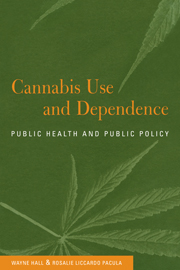Book contents
- Frontmatter
- Dedication
- Contents
- List of figures and tables
- Foreword
- Acknowledgements
- 1 Introduction
- Section 1 Cannabis the drug and how it is used
- 2 Cannabis the drug
- 3 Patterns of use
- Section 2 The health effects of cannabis
- Section 3 The psychological effects of chronic cannabis use
- Section 4 Effects on adolescent development
- Section 5 Harms and benefits of cannabis use
- Section 6 The effectiveness and costs of cannabis prohibition
- Section 7 Policy alternatives
- Appendix 1
- Appendix 2
- References
- Index
2 - Cannabis the drug
from Section 1 - Cannabis the drug and how it is used
Published online by Cambridge University Press: 05 July 2016
- Frontmatter
- Dedication
- Contents
- List of figures and tables
- Foreword
- Acknowledgements
- 1 Introduction
- Section 1 Cannabis the drug and how it is used
- 2 Cannabis the drug
- 3 Patterns of use
- Section 2 The health effects of cannabis
- Section 3 The psychological effects of chronic cannabis use
- Section 4 Effects on adolescent development
- Section 5 Harms and benefits of cannabis use
- Section 6 The effectiveness and costs of cannabis prohibition
- Section 7 Policy alternatives
- Appendix 1
- Appendix 2
- References
- Index
Summary
Cannabis preparations are obtained from the plant Cannabis sativa which occurs in male and female forms. The cannabis plant contains more than 66 cannabinoids (ElSohly, 2002), substances that are unique to the plant. The cannabinoid that is responsible for the psychoactive effects sought by cannabis users is A9- tetrahydrocannabinol or THC (Martin and Cone, 1999; Iversen, 2000). It is found in the resin that covers the flowering tops and upper leaves of the female plant (Clarke and Watson, 2002). Most of the other cannabinoids either do not have psychoactive effects or are only weakly active, although they may interact with THC (Martin and Cone, 1999; Iversen, 2000).
The most common cannabis preparations are marijuana, hashish and hash oil. Marijuana is prepared from the dried flowering tops and leaves of the plant. Its THC content depends upon the growing conditions, the genetic characteristics of the plant, and the part of the plant that is used (Clarke and Watson, 2002). The flowering tops have the highest THC concentration with much lower concentrations in the leaves, stems and seeds. Cannabis plants may be grown to maximise their THC production by the ‘sinsemilla’ method in which only female plants are grown together (Clarke and Watson, 2002).
The concentration of THC in marijuana may range from 0.5% to 5% (ElSohly et al, 2000) while ‘sinsemilla’ may contain 7% to 14% (ElSohly et al., 2000). The potency of marijuana sold in the USA has probably increased over the past several decades (ElSohly et al., 2000) although it has not increased 30 times as has been claimed in the media (Hall and Swift, 2000). Hashish or hash consists of dried cannabis resin containing 2% to 8% of THC. Hash oil which is obtained by extracting THC from hashish (or marijuana) in oil contains 15% to 20% (Adams and Martin, 1996).
Cannabis is typically smoked as marijuana in a hand-rolled cigarette or ‘joint’ which may include tobacco to assist burning. A water pipe or ‘bong’ is an increasingly popular way of using all cannabis preparations (Hall and Swift, 2000). Hashish may be mixed with tobacco and smoked as a joint or smoked in a pipe, with or without tobacco.
- Type
- Chapter
- Information
- Cannabis Use and DependencePublic Health and Public Policy, pp. 13 - 17Publisher: Cambridge University PressPrint publication year: 2002



